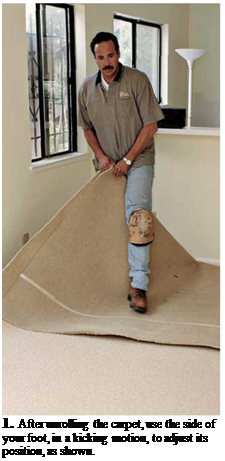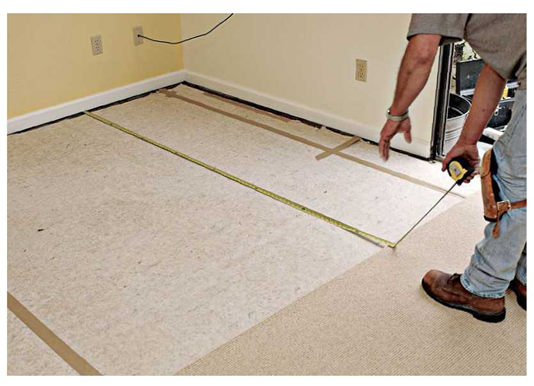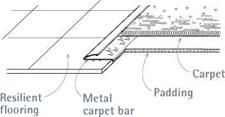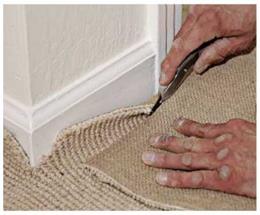ROUGH-CUTTING CARPET
When rough-cutting carpet, it’s helpful if you can unroll it completely. If you don’t have enough room to do so indoors, unroll it on a clean, dry sidewalk or driveway. Sweep the area well beforehand, and make sure there are no oil stains on the ground.
Cut the carpet to the overall room dimensions on your sketch—plus the extra you included for seams and trimming along walls. At this stage, don’t cut out carpet jogs, such as along cabinets and around doorways, because you’ll cut those later, when the carpet is spread out in the floor you’re carpeting. Important: Before making any cuts, note the direction of the carpet pile, especially if you have more than one piece of carpeting to cut.
|
|
|
Edge tucked with stair tool
Wood flooring Tackless strip |
Tape the edge of the padding to keep it from riding up onto the tackless strips when stretching the carpet.
Transfer the room dimensions to the carpet. Use a felt-tip marker on the edge of the carpet to indicate the cut-line across its width, or use a utility knife to notch the carpet’s edges at each end of the proposed cut.
In general, cut loop-pile carpet from its pile side (its face), and cut cut-pile carpet from its backing side. To cut carpet with cut pile, flop the edge of the carpet over so its backing is up, and snap a chalkline between the two notches you made in the carpet’s edges. Cut along the chalkline with a utility knife or a double-edged floor-
|
|
|
3. Before hot-taping carpet seams, help the carpet lie flat by notching carpet edges where they abut doorways, cabinets, and so on. |
 |
 |
ing knife, using a long metal straightedge to guide the blade. If the carpet is loop pile, cut it with the carpet facing up: Locate a pile row near the cut-line and run the blade of a large flat screwdriver between them, to separate the rows. Then push a row runner, as shown in the bottom photo on p. 509, steadily down the row to cut through the backing. The carpet pile will guide the cut.









Leave a reply